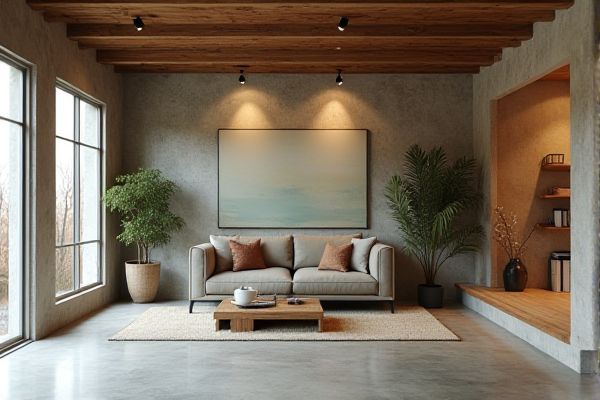
Painted concrete offers a solid, opaque finish that can completely transform the surface's color and appearance, while stained concrete penetrates the surface to create a more natural, variegated look that enhances the concrete's texture and depth. Discover which option best suits your style and needs by exploring the rest of the article.
Table of Comparison
| Feature | Painted Concrete | Stained Concrete |
|---|---|---|
| Appearance | Opaque, solid color, uniform finish | Translucent, enhances natural texture and patterns |
| Durability | Prone to chipping and peeling over time | Long-lasting, resists fading and peeling |
| Application | Requires primer and multiple coats of paint | Applied as a chemical stain that penetrates concrete |
| Maintenance | May need frequent repainting and touch-ups | Low maintenance; occasional resealing recommended |
| Cost | Generally lower upfront cost | Higher initial cost but longer lifespan reduces overall expenses |
| Color Variety | Wide range of solid colors | Limited to stain colors but offers natural variation |
| Best Use | Decorative surfaces requiring consistent color | Outdoor patios, driveways, and high-traffic areas |
Understanding Painted Concrete vs Stained Concrete
Painted concrete offers a solid, opaque color layer that completely covers the surface, providing uniformity and the ability to hide imperfections, while stained concrete penetrates the surface to enhance the natural texture and variations of the concrete with semi-transparent hues. You should consider painted concrete for bold, consistent color schemes in high-traffic areas, whereas stained concrete is ideal for achieving a more natural, variegated look with increased durability and resistance to chipping. Both methods improve concrete aesthetics but differ significantly in application, maintenance, and appearance longevity.
Key Differences in Appearance
Painted concrete offers a solid, opaque color that completely covers the surface, providing a uniform and vibrant finish. Stained concrete enhances the natural texture and patterns of the concrete by penetrating the surface with translucent colors, resulting in a variegated, marble-like appearance. The key difference lies in paint creating a layer on top, while stains chemically bond and highlight the concrete's inherent characteristics.
Durability and Longevity Comparison
Painted concrete offers a vibrant finish but tends to chip and fade more quickly under heavy foot traffic and harsh weather conditions, requiring frequent touch-ups. Stained concrete penetrates the surface with color, enhancing durability by resisting peeling and cracking while preserving the natural texture and appearance longer. Choosing stained concrete for your project ensures better longevity and reduced maintenance compared to painted options.
Installation Process Overview
Painted concrete involves applying a primer followed by multiple coats of paint, requiring thorough surface cleaning and drying to ensure adhesion and durability. Stained concrete requires a cleaner surface and application of acid-based or water-based stains, which chemically react with the concrete to create a translucent, variegated finish that penetrates the surface for long-lasting color. Your choice between painted and stained concrete should consider the installation time, surface preparation intensity, and desired aesthetic effects.
Maintenance Requirements for Both Options
Painted concrete requires regular touch-ups and repainting every 2-3 years due to chipping and fading caused by weather and foot traffic. Stained concrete offers lower maintenance, relying primarily on periodic resealing every 2-4 years to preserve its color and protect against surface wear. Both options benefit from routine cleaning with mild detergents to prevent dirt buildup and maintain aesthetic appeal.
Cost Analysis: Painted vs Stained Concrete
Painted concrete typically costs between $1 and $3 per square foot, offering a budget-friendly option for quick surface color changes but may require more frequent maintenance and touch-ups. Stained concrete ranges from $2 to $7 per square foot due to its deeper penetration and longer-lasting color, providing a durable finish resistant to chipping and peeling. While stained concrete has a higher upfront cost, its longevity and low maintenance often result in better long-term value compared to painted concrete.
Design and Color Versatility
Painted concrete offers a wide range of solid, opaque color options ideal for creating bold, uniform surfaces with high design control. Stained concrete provides rich, translucent tones that enhance the natural texture and variation of the concrete for a more organic and variegated appearance. Both techniques allow customization, but stained concrete excels in subtle depth and color blending, while painted concrete is preferred for vibrant, consistent color coverage.
Ideal Applications for Each Finish
Painted concrete is ideal for high-traffic areas like garages, warehouses, and patios where a uniform, vibrant color and robust protection against wear and moisture are essential. Stained concrete suits decorative applications such as residential floors, commercial lobbies, and outdoor walkways, offering a natural, variegated appearance that enhances architectural details and mimics the look of stone or wood. Choosing between painted and stained concrete depends on whether durability and color consistency or aesthetic depth and subtlety are the primary goals for the space.
Pros and Cons of Painted Concrete
Painted concrete offers a vibrant and customizable finish that enhances curb appeal and protects against surface wear and moisture damage. However, it tends to peel and chip over time, requiring regular maintenance and repainting to preserve its appearance. While painting provides cost-effective easy application, it lacks the penetrating durability and natural look that stained concrete offers.
Pros and Cons of Stained Concrete
Stained concrete offers a durable, low-maintenance finish that enhances the natural texture and appearance of concrete with vibrant, translucent colors resistant to fading and peeling. Its porous nature allows for better adhesion and prevents chipping, but it may require periodic resealing to protect against stains and wear in high-traffic areas. You benefit from a more natural, elegant look compared to painted concrete, though the color options are less opaque and customizable.
 homyna.com
homyna.com